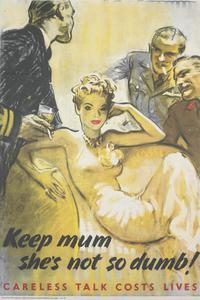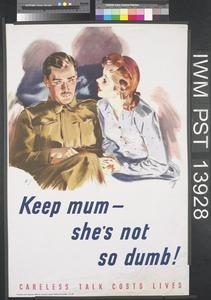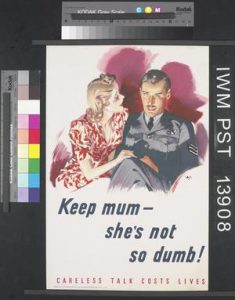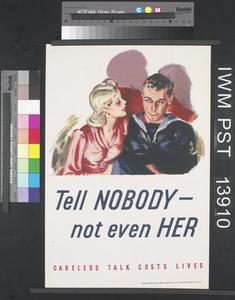
For British citizens, World War II was a people’s war. That was not only a common thread in British propaganda of that time, but an unavoidable truth. War had invaded the lives of British citizens in multiple ways. It had invaded their homes in the form of bombs demolishing their houses and churches; therefore, restructuring their infrastructure. It had interrupted their daily lifestyles – forcing many to subsist on rationed food and donating much of their goods to the war effort. It had invaded their minds by creating a fear and distrust of people around them and cultivating an understanding that words hold the power to destroy. Especially when the wrong words were spoken to an enemy spy.

British propagandists realized that they needed to stress to the significance of keeping gossip at bay. That led the Ministry of Information to create a series of posters where “one of the biggest initiatives was an anti-gossip campaign, reminding the public that information falling on the wrong ears could be useful to the enemy” (Curtis 11). The “Careless Talk” posters were produced by a variety of artists, but they shared the singular notion that gossip can led to death. Many of these posters were meant to inspire fear using violent depictions of what could happen if someone were to talk carelessly. For example:

This picture, taken from the Imperial War Museum’s website
http://www.iwm.org.uk/collections/search?query=careless+talk&items_per_page=10 , focuses its attention on the destruction that is caused by careless talk. It shows how gossip can literally sink ships.
Keep Mum – She’s Not so Dumb! posters have a different agenda. They also stress the importance of not speaking carelessly; however, they used a different method.

This Keep Mum – She’s Not so Dumb poster uses humor and not fear to convey the same message. It does this by focusing more on the cause of destruction, and less on the destruction itself. The cause of destruction in these posters are “not so dumb” women. Since the poster was made for men (more specifically soldiers with information about the war) , the humor was also male targeted humor. Male soldiers seeing this in 1941, when it was created by artist Harold Foster, would have chuckled at the sight of their fellow soldiers carelessly talking about war in front of an woman they consider dumb. They might have nodded their heads and said, “Yes. Women are not so dumb” and “they could be spies”. In that way, this poster effectively sets up an acceptable villain for a male audience.
According to Sue Ann Riley in the article Loose Lips Sinks Ships: American Propaganda in WWII , “British…propaganda depicted the war as an issue of good versus evil” (51). The “Careless Talk” poster series is no exception to this rule. Foster’s poster shows three apparently “good” soldiers carelessly gossiping over a devious “evil” woman. The picture itself seems to point at a certain kind of woman. The fact that she is surrounded by men and wearing red lipstick indicates that she is a promiscuous woman. Her jewelry and her dress indicates that she is used to extravagances. This woman gives off the impression that she is listening with a specific intent. This depiction of the “promiscuous extravagant” woman was not the only kind of woman that was vilified in the “Careless Talk” series. For example:



The woman in these pictures are closer to the soldiers than than the “promiscuous extravagant” woman. Although each of these pictures may be geared to a different kind of soldier, a British infantry man, a member of the Royal Air Force and a British sailor, the message is the same. Do not trust even the women closest to you with information. While she is eagerly extracting information from you, she could very well, carry that information into enemy hands.
These posters lead to an interesting question:
Were these posters an accurate depiction of British women during WWII?
Contrary to what these posters were trying to convey, women were not all untrustworthy in the war. In fact, according to Sonya Rose in the article Women’s Rights, Women’s Obligations: Contradictions of Citizenship in WWII Britain, “In April 1941 the government began registering women so that they could be directed into war work” (279). The government trusted women enough to make them an active part in the war; however, their efforts were not glorified. They filled a specific need for the government, but were still viewed as the main cause behind espionage in Britain.
Although there were female spies in Britain, it is important to note that there were also many male spies as well. The “Careless Talk” posters depicting women as the cause of information leaks were not as effective as they could have been. The efficacy of these posters could have been increased if they showed that “careless talk” was not gender specific.
References
http://www.bbc.co.uk/history/events/the_blitz
Curtis, J. (2000, Oct 12). Advertising through the ages. Marketing, , 10-15. Retrieved from
http://www.iwm.org.uk/collections/search?query=careless+talk&items_per_page=10
Riley, S. A. (2012, 10). LOOSE LIPS SINK SHIPS: American propaganda in WWII.Sea Classics, 45, 50-57. Retrieved from http://york.ezproxy.cuny.edu:2048/login?url=https://search-proquest-com.york.ezproxy.cuny.edu/docview/1036643657?accountid=15180
Rose, S. O. (2000). Women’s rights, women’s obligations: Contradictions of citizenship in world war II britain. European Review of History, 7(2), 277-289. Retrieved from http://york.ezproxy.cuny.edu:2048/login?url=https://search-proquest-com.york.ezproxy.cuny.edu/docview/210633344?accountid=15180







Melissa Dinsman
Very nice connections between the Keep Mum poster and the others in the series. One has to wonder about the possible long-term impact such campaigns might have had in sowing distrust between men and women or on falling back on the old stereotype of women as gossips.
Jack
Claudia, I like how you explained the power and danger of something as simple as words. One might not expect that women had a role to play in the war in terms of “spying” or releasing information; however, these posters definitely emphasize the caution and danger that men have to implement when interacting with women. I agree with you about these posters being gender specific and I do think that the effectiveness could have increased if it was focused more on the general public rather than primarily women. It is apparent that anyone could have released important information which of course could have been men and may have been men in some cases.
Saudia Haniff
Claudia, I enjoyed reading your blogpost and I found it very informative. Who would’ve known that although these posters may look similar they have different meanings? My favorite part was when you discussed the poster about the promiscuous women, it definitely caught my attention.
Fahmida Begum
The series you incorporated were really informative and you put a lot of examples to show how this propaganda was significant in Britain. I realize the posters were being sexist towards women that only men knew the information and women were kept in the dark and assuming that it was them.